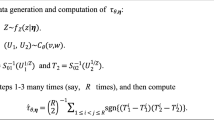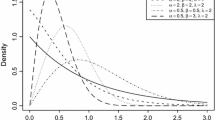Abstract
Many existing latent failure time models for competing risks do not provide closed form expressions of sub-distribution functions. This paper suggests a generalized FGM copula models with the Burr III failure time distribution such that the sub-distribution functions have closed form expressions. Under the suggested model, we develop a likelihood-based inference method along with its computational tools and asymptotic theory. Based on the expressions of the sub-distribution functions, we propose goodness-of-fit tests. Simulations are conducted to examine the performance of the proposed methods. A real data from the reliability analysis of the radio transmitter-receivers are analyzed to illustrate the proposed methods. The computational programs are made available in the R package GFGM.copula.




Similar content being viewed by others
References
Amini M, Jabbari H, Mohtashami Borzadaran GR (2011) Aspects of dependence in generalized Farlie–Gumbel–Morgenstern distributions. Commun Stat Simul Comput 40(8):1192–1205
Bairamov I, Bayramoglu K (2013) From the Huang–Kotz FGM distribution to Baker’s bivariate distribution. J Multivar Anal 113:106–115
Bairamov I, Kotz S (2002) Dependence structure and symmetry of Huang–Kotz FGM distributions and their extensions. Metrika 56(1):55–72
Bakoyannis G, Touloumi G (2012) Practical methods for competing risks data: a review. Stat Methods Med Res 21(3):257–272
Basu AP, Ghosh JK (1978) Identifiability of the multinormal and other distributions under competing risks model. J Multivar Anal 8(3):413–429
Braekers R, Veraverbeke N (2005) A copula-graphic estimator for the conditional survival function under dependent censoring. Can J Stat 33(3):429–447
Burr IW (1942) Cumulative frequency functions. Ann Math Stat 13:215–232
Chen Y-H (2010) Semiparametric marginal regression analysis for dependent competing risks under an assumed copula. J R Stat Soc B 72(2):235–251
Crowder MJ (2001) Classical competing risks. Chapman and Hall/CRC, Boca Raton
David HA, Moeschberger ML (1978) The theory of competing risks, vol 39. Griffin, London
de Uña-Álvarez J, Veraverbeke N (2013) Generalized copula-graphic estimator. Test 22(2):343–360
de Uña-Álvarez J, Veraverbeke N (2017) Copula-graphic estimation with left-truncated and right-censored data. Statistics 51(2):387–403
Domma F, Giordano S (2013) A copula-based approach to account for dependence in stress-strength models. Stat Pap 54(3):807–826
Domma F, Giordano S (2016) Concomitants of m-generalized order statistics from generalized Farlie-Gumbel-Morgenstern distribution family. J Comput Appl Math 294:413–435
Durante F, Sempi C (2015) Principles of copula theory. CRC Press, Boca Raton
Efron B, Tibshirani RJ (1993) An introduction to the bootstrap. Chapman & Hall, London
Emura T (2017) joint.Cox: Penalized likelihood estimation and dynamic prediction under the joint frailty-copula models between tumour progression and death for meta-analysis, CRAN, R package version 2.13
Emura T, Chen Y-H (2016) Gene selection for survival data under dependent censoring: a copula-based approach. Stat Methods Med Res 25(6):2840–2857
Emura T, Chen YH (2018) Analysis of Survival Data with Dependent Censoring. Copula-Based Approaches. JSS Research Series in Statistics, Springer, Singapore
Emura T, Michimae H (2017) A copula-based inference to piecewise exponential models under dependent censoring, with application to time to metamorphosis of salamander larvae. Environ Ecol Stat 24(1):151–173
Emura T, Nakatochi M, Murotani K, Rondeau V (2015) A joint frailty-copula model between tumor progression and death for meta-analysis. Stat Methods Med Res. https://doi.org/10.1177/0962280215604510
Escarela G, Carrière JF (2003) Fitting competing risks with an assumed copula. Stat Methods Med Res 12(4):333–349
Eyraud H (1936) Les principes de la mesure des correlations. Ann Univ Lyon III Ser Sect A 1:30–47
Fan T-H, Hsu T-M (2015) Statistical inference of a two-component series system with correlated log-normal lifetime distribution under multiple type-I censoring. IEEE Trans Reliab 64(1):376–385
Gumbel EJ (1960) Bivariate exponential distributions. J Am Stat Assoc 55(292):698–707
Heckman JJ, Honore BE (1989) The identifiability of the competing risks models. Biometrika 76:325–330
Hsu T-M, Emura T, Fan T-H (2016) Reliability inference for a copula-based series system life test under multiple type-I censoring. IEEE Trans Reliab 65(1):1069–1080
Hu Y-H, Emura T (2015) Maximum likelihood estimation for a special exponential family under random double-truncation. Comput Stat 30(4):1199–1229
Huang JS, Kotz S (1999) Modifications of the Farlie–Gumbel–Morgenstern distributions. A tough hill to climb. Metrika 49:135–145
Knight K (2000) Mathematical statistics. Chapman and Hall, Boca Raton
Lawless JF (2003) Statistical models and methods for lifetime data, 2nd edn. Wiley, Hoboken
Lehmann EL, Casella G (1998) Theory of point estimation, 2nd edn. Springer, New York
Lindsay SR, Wood GR, Woollons RC (1996) Modelling the diameter distribution of forest stands using the Burr distribution. J Appl Stat 23(6):609–620
Meeker WQ, Escobar LA (1998) Statistical methods for reliability data. Wiley, New York
Mendenhall W, Hader RJ (1958) Estimation of parameters of mixed exponential distributed failure time distribution from censored life test data. Biometrika 45(3–4):504–520
Moeschberger ML (1974) Life tests under dependent competing causes of failure. Technometrics 16(1):39–47
Mokhlis NA (2005) Reliability of a stress-strength model with Burr type III distributions. Commun Stat Theory Methods 34(7):1643–1657
Morgenstern D (1956) Einfache Beispiele zweidimensionaler Verteilungen. Mitteilungsblatt für Mathematishe Statistik 8:234–235
Navarro J (2016) Distribution-free comparison of residual lifetimes of coherent systems based on copula properties. Stat Pap. https://doi.org/10.1007/s00362-016-0789-0
Nelsen RB (2006) An introduction to copulas, 2nd edn. Springer, New York
Ramsay JO (1988) Monotone regression splines in action. Stat Sci 3(4):425–461
Rivest LP, Wells MT (2001) A martingale approach to the copula-graphic estimator for the survival function under dependent censoring. J Multivar Anal 79:138–155
Shao Q (2000) Estimation for hazardous concentrations based on NOEC toxicity data: an alternative approach. Environmetrics 11:583–595
Sherrick BJ, Garcia P, Tirupattur V (1996) Recovering probabilistic information form option markets: test of distributional assumptions. J Futures Mark 16(5):545–560
Shih J-H (2018) R GFGM.copula: Generalized Farlie–Gumbel–Morgenstern Copula, CRAN: version 1.0.2
Shih J-H, Emura T (2016) Bivariate dependence measures and bivariate competing risks models under the generalized FGM copula. Stat Pap. https://doi.org/10.1007/s00362-016-0865-5
Staplin ND, Kimber AC, Collett D, Roderick PJ (2015) “Dependent censoring in piecewise exponential survival models. Stat Methods Med Res 24(3):325–341
Tsiatis A (1975) A nonidentifiability aspect of the problem of competing risks. Proc Natl Acad Sci USA 72(1):20–22
Zheng M, Klein JP (1995) Estimates of marginal survival for dependent competing risks based on an assumed copula. Biometrika 82(1):127–138
Acknowledgements
The authors thank the co-editor and two anonymous reviewers for their helpful comments that greatly improved the presentation of the paper. This work is supported by the research grants funded by the government of Taiwan (MOST 103-2118-M-008-MY2; MOST 105-2118-M-008-003-MY2).
Author information
Authors and Affiliations
Corresponding author
Electronic supplementary material
Below is the link to the electronic supplementary material.
Rights and permissions
About this article
Cite this article
Shih, JH., Emura, T. Likelihood-based inference for bivariate latent failure time models with competing risks under the generalized FGM copula. Comput Stat 33, 1293–1323 (2018). https://doi.org/10.1007/s00180-018-0804-0
Received:
Accepted:
Published:
Issue Date:
DOI: https://doi.org/10.1007/s00180-018-0804-0




